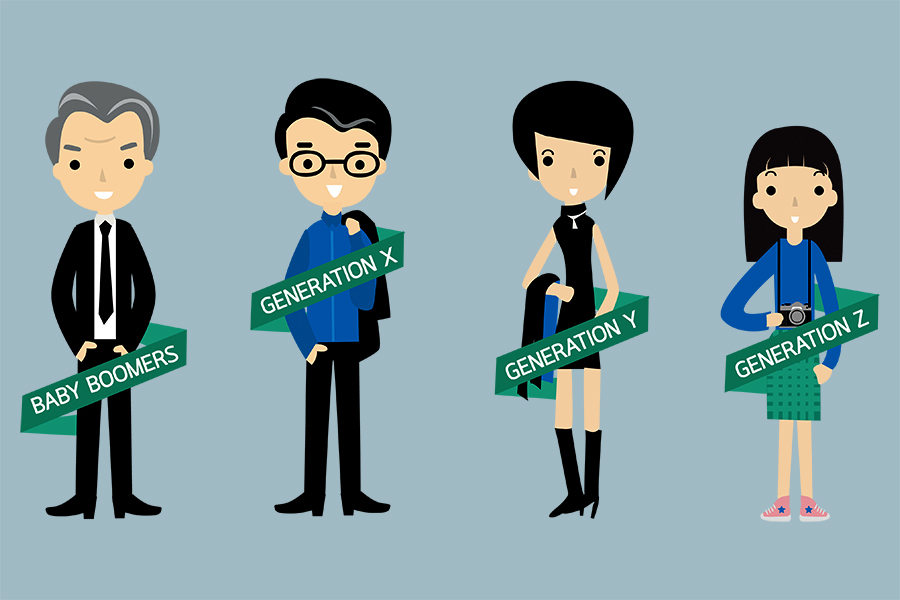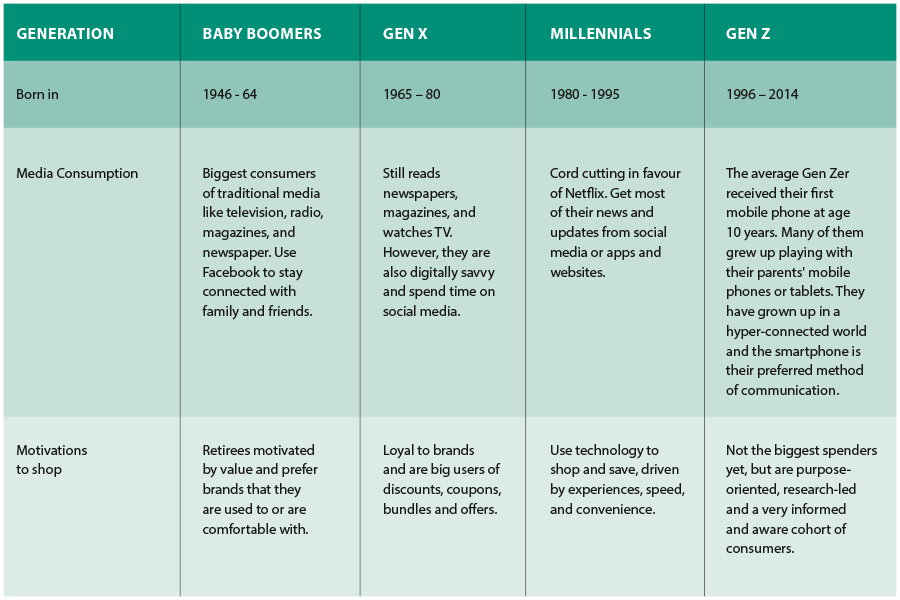
Internet is one of the most powerful inventions of all time, the potential of which only keeps evolving and growing with every passing year. From macro economies to basic human behaviour, the internet seems to actively or passively govern many things that happen in the world today. As is with most industries, the advent of newer technologies has changed the whole face of retail in the recent past and since the customer is always at the heart of any retail decision, the way they behave has directly resulted in all the drastic transformations and evolution the sector has seen.
Every customer, depending on their gender, culture, background, personal likes and dislikes, and age behaves differently. However, if it needs to be broadly classified, most retailers agree that there are three types of customers – one that was born before the internet era and lived the majority of their life without it, one that was born before the internet became mainstream but are living through the transition of the internet phenomenon, and the ones that were born into a world that can’t live without the internet. Sociologically, these three demographics are termed Baby Boomers, Millennials and Generation Z.
However, Apparel Group’s Dharmin Ved believes that today there are only two types of consumers. “One that was born when phones didn’t exist and one that was born when phones already existed. The latter are native online shoppers and the former had to do the shift online,” he said.
“What we have to offer is something that both these generations are able to use within the platform and make it easy and convenient for both these generations to use and experience our offerings. When we look at each of the customers, the native ones will be able to experience our digital offering (like the app) much deeper. You can see the difference in behaviour within the app. The incumbents will have a different kind of usage and experience and that is where personalization comes into play – to understand how we can cater to both these journeys separately and service them separately. Things like click-and-collect are more popular with the older generation while the younger ones say that they want it delivered,” he added.

OK, Boomer!
Let’s break it down. Baby boomers are the ones born between 1946 and 1964. This is the generation that has already retired or is on the verge of retirement, still follows traditional ways of consumption – be it media (cable TV, newspapers, etc) or products and uses technology mainly to stay in touch with family and friends. The next generation, classified as Generation X, are the ones born between 1965 and 1980. This generation understands and may even be habituated to traditional means of consumption but is better positioned to adapt to the digital world. They are the ones who are trying to raise a family as well as taking care of aging parents, are managing debts and feel the need and urge to save for the future. Therefore, when it comes to shopping behaviour, they appreciate value for money. According to eMarketer, 86% of Xers said they would try a new brand if offered a coupon or discount.
Many Gen X shoppers are choosing from both online and offline coupons with the best deals winning out. They are also seen to have a high affinity for the brands they trust and tend to have the highest brand loyalty amongst all the generations of shoppers. Unlike the Baby Boomers, Gen X is comfortable using both digital as well as traditional platforms, giving retailers and marketers more flexibility in reaching out to them. During the pandemic, a good chunk of Xers didn’t use their disposable income that they would have used otherwise so some major purchases including cars, home, or travel can be expected from them in the months to come.
So what could work for this cohort of customers would be straightforward communication on multichannel platforms, discounts, cashback and bulk offers and strong loyalty programs that rewards brilliant value for money.
Gen Me
Millennials or Gen Y display similar traits as that of Gen X. This generation too has experienced both the “IRL” and the online world but is more digital and social media savvy than the previous generation. Some of defining moments that shape a lot of their behaviour include the great recession, technological explosion, and the advent of social media. Cord-cutting in favour of Netflix is a theme very common amongst this generation so if brands are trying to reach this cohort through mainstream TV adverts, then they might need to reconsider. Now, millennials today are the largest group in the workforce with tremendous purchasing power. They lean towards being product and feature-first as opposed to being brand and loyalty-first. According to a recent survey, 33% of millennials rely on blogs before making a purchase and eight out of 10 millennials never buy anything without reading a review first. There is an element of purpose, cause and social consciousness that this generation cares about. They tend to support brands that support a cause that is close to their heart, be it environmental or social. Moreover, this cohort is less materialistic than their older counterparts and hence chooses access over ownership, and experiences over materials.
In order to reach millennials, brands and retailers need to truly become omnichannel. Millennials are transfixed to social media and respond better to brands that connect with them on social channels. However, they are also craving in-person experiences so it is paramount for retailers to be at every touchpoint. Retailers also need to integrate their operational elements so that they can have a single “conversation” with customers, not one that changes from smartphone to PC to physical store.
Freedom for zoomers
And finally Gen Z, the ones born between 1997 to 2015, is the cohort that every business is studying, watching out for and frankly, a bit scared of too. They are the ones that are born with mobiles and therefore are well connected, more global citizens, and very technologically savvy. They are also the ones who have seen their parents (Gen X) struggle from debts and give up on leisure and experiences and are seen to be trying to not replicate those mistakes. If there can be one word to describe what Gen Z is after, it would be freedom. Froom from debt, freedom to be mobile, freedom of choice and expression. And that is reflected in their shopping behaviour too.
This generation is very demanding as they are very informed. They know what they want and what they are looking for in brands and products. So it would be best for brands to be transparent, authentic and be able to deliver on their promises. A recent McKinsey and Co. report called Gen Z, the True Gen, as all their findings pointed towards the generation seeking the truth. Authenticity and purpose become key in defining their choices. Social media has the largest impact on influencing purchase decisions for Gen Z. With 80% of purchases by this generation influenced by social media, the channels making the biggest impact are Instagram, Snapchat, and YouTube. The youngest cohort also responds well to social media influencers and user-generated content.
“When it comes to Millennials and Gen Z, they are a very informed lot. They do their own research, they have all the information available to them as they are tech-savvy. We have our product range and offerings in terms of wireless technology, music, wearables for this populace, where they can leverage all of these gadgets for their own benefit and create their own data analysis,” said Rushikesh Bhatt, Head of IT at Eros Group.
“The older generation isn’t as tech-savvy so we have products that cater to their needs. We recently launched our Saregama jukebox which has 5000 old songs stored in them. If my father wants to listen to a song, he wouldn’t want to download Amazon Music or Deezer. He would just want to tune in to his song traditionally. For the older generation it is convenience, for Gen Z, it is about what the technology offers and how to make the most of what is packed in a small gadget. This is what our data has shown us too. They want the latest gadget for gaming etc. that are power-packed, faster, and they want to be a step ahead,” said Rushikesh Bhatt, Head of IT at EROS Group.
Knowing generational trends is important for brands and retailers to cater to them properly, but this isn’t the only way to categorize human behavior. Every consumer behaves as an individual whose personal choices govern their purchasing behaviour. That is where data and personalization come into play – to understand their past purchases, give recommendations, and maximise conversion while minimizing wasted marketing.
“It’s not just age, but also culture. Culturally people have a specific shopping habit, where they would want to go to a supermarket or want to do things differently. We want to give all kinds of options to the consumer. It’s only a matter of time until the age or culture barrier is overcome with the customers transitioning (to adapt to a digital world). We aren’t necessarily expecting them to always do online shopping, they do like going to the mall, so it’s all going to be in the mix. However I feel that the demographics are going to change, with the younger generation leading the e-commerce wave,” said Halima Jumani, Director at Kibsons.
You must be logged in to post a comment.